The Memotech MTX
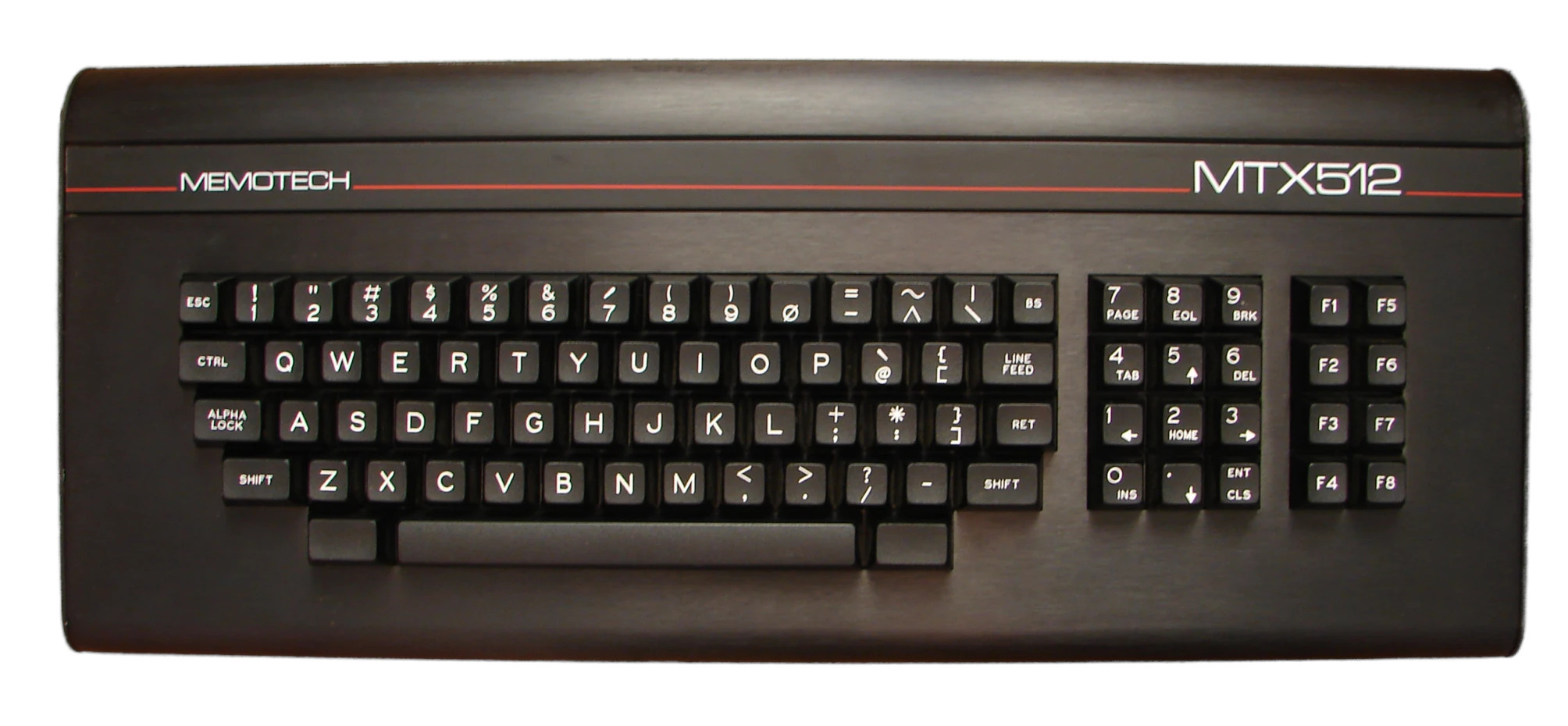
Released in June 1983 at a starting price of £275 (£934 in 2025), the Memotech MTX was an 8-bit microcomputer based around the Z80 aimed at both the home and business markets. A competently executed machine with an array of interesting features and striking industrial design, it deserved better sales than it ultimately achieved, selling perhaps in the region of 20,000 - 30,000 units based on serial number estimates.
History
Memotech was founded in 1981 by two Oxford University graduates, Geoff Boyd and Robert Branton. The company was initially known for producing memory expansion devices for the Sinclair ZX81, which was noted for being particularly short of RAM and an expansion was a necessary add-on. This endeavour was very successful and the company grew to more than 100 employees.
Memotech added an innovation to the production process which was a low cost memory testing device. DRAM chips were often unreliable and needed to be tested. Memotech's answer to this problem was a homemade test unit that was vastly cheaper than the industrial equivalent Sinclair themselves were using. The lower cost of the machine enabled Memotech to both test memory considerably quicker and achieve a lower price-point. This left the company well positioned to take advantage of Sinclair product shortages. Memotech also produced a number of other peripherals for the ZX81 including serial and printer interfaces as well as improved keyboards.
When the Sinclair Spectrum was announced, it had considerably more RAM that the ZX81. This presented a problem for Memotech as the amount provided as standard was likely sufficient for the typical home user and this would lead to the demise of the memory expansion business, which was most of the sales. It was at this point they decided to enter the home computer market with their own machine. Memotech had previously contracted Steve Marchant to produce an experimental Z80 system called the SM1 (Steve Marchant 1) and the MTX would be derived from this design.
By 1985, there was a prospect of a promising order from the former Soviet Union, which was interested in CP/M machines for use in its schools. Orders were anticipated to be in the region of 200,000 units plus. Memotech commissioned a special version of the MTX with a bright red case. The main part of the work was converting the machine to operate in Russian language. The MTX already had multi-langauge features and this was more achievable than on other machines, which operated in one character set only. Unfortunately though, the deal fell through and the Soviet Union decided to acquire machines based on the MSX standard instead and then only 10,000 units.
Specifications
Two versions of the MTX were initially released: the MTX500 had 32KB of user memory and the MTX512 had 64KB. Both contained an additional 16KB of memory for the video frame buffer. The separate frame buffer memory was a particularly generous addition as commonly machines of the era, often unbeknownst to the buyer, would consume a non-trivial fraction of the advertised RAM to store the display. As memory was a particular competency of Memotech it was perhaps not surprising that a large memory ceiling was a core feature of the machine. Both versions could be upgraded to 512K, which was a very large amount of RAM for a home computer at the time and far exceeded the capability of most competing machines. An expanded RS128 model with 128K base memory would follow later.
The CPU was a Zilog Z80A at 4Mhz which delivered performance about average for competing machines of the era. It featured a TMS9929A graphics chip (or TMS9928A for other regions) that could produce a resolution of 256x192 in 15 colours (there is a 16th "colour" but this is transparent). The chip has bitmap output and limitations similar to the ZX Spectrum and like that machine the colour of each pixel is not individually addressable but the rules for colour selection are more flexible. The screen is divided horizontally into groups of 8 adjacent pixels and each of those groups may only have one of two colours selected from the palette. However, pixels on different lines can have different colours.
A significant improvement over the Spectrum though was the provision of 32 hardware sprites which enabled fast and smooth game character movement around the screen. These could be either 8x8 or 16x16 pixels. Each sprite could only be one colour but it was possible to layer sprites over the top of each other to produce the effect of a single multicoloured sprite.
Sound was delivered via an SN76489A chip which was similar to that used in the BBC Micro.
Expansion
The machine has a centronics printer port for dot matrix printers, a 2400 baud cassette port, a TV UHF connector, composite video and two joystick ports. On the left hand side there is a generic edge connector offering access to the system bus and this can also be used as a cartridge port.
There's a generic parallel I/O port but the only access to this is from inside the case via a DIL socket and there is no external connector. There is one internal card slot that can accept two cards via daisy chaining. An optional card was available for the slot with an RS232 port and a disk interface controller.

Disk Interfaces
A floppy disc system was available by 1984 called the FDX that included either one or two 5.25" drives and a Western Digital SASI interface that could support up to four drives in total via a connector on the read. In addition, a novel option was provision for RAM disk cards in the same chassis. These cards emulated CP/M disks and could dramatically accelerate the performance of software over using it from floppy. Potentially up to 32MB of solid state storage could be added to the unit, although this much memory would have been impossibly expensive for most at the time of launch.
The intent of the FDX was not just as a floppy disk unit but more as an adapter to convert the Memotech into a professional business machine. A copy of CP/M 2.2, the Supercalc spreadsheet and a word processor called "New Word" that was similar to WordStar were bundled with the device, signalling the intended market. In addition the peripheral included an 80 column video card, which was often required to run CP/M software. The card was colour whereas competing machines were often monochrome.
The dual drive version of the FDX was initially sold for £870 (About £2800 in 2025) and at this price was clearly not really aimed at the home market but more at business customers. A cheaper disk drive unit would be released in later years. A bundle containing a 256K RAM disk with a single floppy drive was also available at £995. At 1984 prices, additional 256K RAM disks were offered at £385 (about £1200 in 2025).
A hard disk unit called the HDX was also available with sizes from 5 - 20MB and included a single floppy drive.
HRX

The HRX (right - shown also with an HDX hard disk) was an add-on for the MTX developed from 1982 by Chris Marvell and released by 1984. It could display up to a 756*512 pixel interlaced image in 18-bit colour (262,144 colours). This is sufficient to display a frame of standard definition television in full colour, which was well outside of the capability of almost any other home computer at the time, with most devices (including the base MTX) delivering 16 colours at best and usually falling well short of the resolution requirements. Displaying photographic quality images wouldn't be a commonplace feature of a home computer until some years later.
The device could digitise images from a video camera and achieved an input data rate of 7.2Mbytes/s. This enabled it to frame grab an image instantaneously at the full video frame rate, which was again an activity most contemporary home computers would have struggled with. Digital video camera interfaces existed for other home computers but they most usually either had significant colour and resolution limitations and/or relied on the scene the camera was observing to remain stationary for some time whilst the image was slowly read in.
The HRX unit offered a number of photo manipulation effects such as rotation and edge detection and could overlay vector graphics over the image. These features were controlled from the attached MTX computer.
The HRX technology would subsequently be spun off into a company called PicSolve that supplied systems for taking souvenir photos on theme park rides. It would also form the basis of Memotech's later video wall business.
BASIC
The MTX had a good quality BASIC implementation that included commands to control most aspects of the hardware. Graphics primitives such as circle and line drawing were included, which were sometimes missing on competing machines. Hardware sprites could also be defined from BASIC making action games coded in the language feasible whereas they were often only really possible in assembler on competing machines.
Turtle Graphics
The MTX BASIC includes a built-in capability to produce drawings in the style of the Logo language, which was popular for teaching students programming at the time. It introduces students to ideas such as loops by demonstrating how they can avoid repetition when drawing diagrams. For example, a square can be drawn by drawing a line, turning 90 degrees, and repeating this process four times.
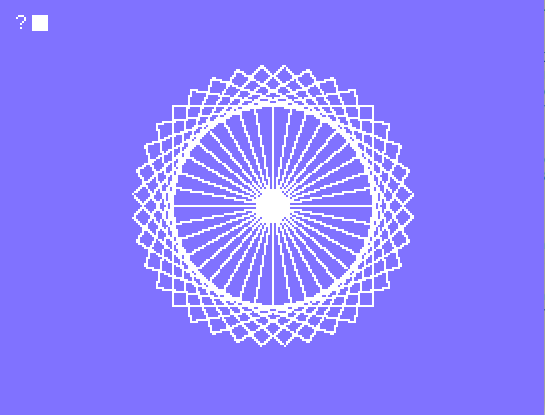
The BASIC DRAW command will draw a line a specific number of pixels from the current position of the turtle. The ANGLE command sets the absolute angle of the turtle and PHI sets the angle relative to the current angle the turtle is pointing. The BASIC code for producing the above diagram is shown below:
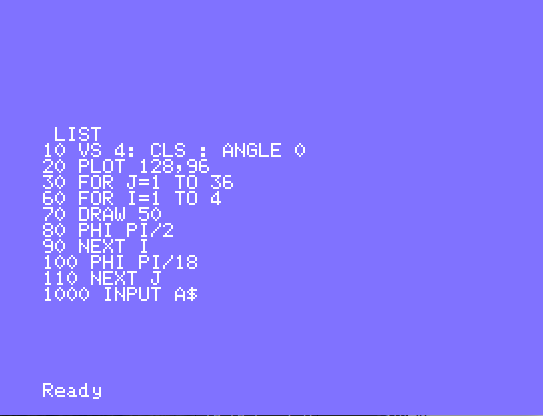
Noddy
There was a novel built-in langauge called "Noddy" which was based around a series of information cards. The user could create cards and type anywhere on the screen. The information entered is then saved under a card name and any card can be recalled for display by name.
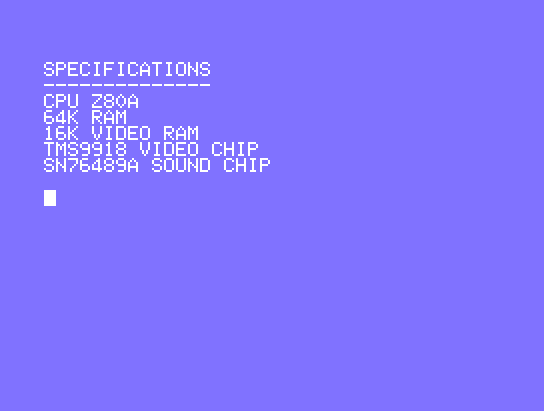
This produces an effect somewhat like a slide deck, however the display of the cards and flow through them can be controlled via code written in the Noddy language, based on user interaction. For example here a menu screen is created. The user needs to press "S" to reach the specifications card that was saved previously.

This is an example of a part of the program for the menu. It begins by displaying the MENU card. The IF statement detects if the "S" key was pressed. If so, it advances to the line label D. Lines in the program are labelled using a caret e.g. ^D. If a key other than "S" is pressed then the program falls through to a statement to return control to the caller.

Noddy programs could also be started from BASIC using the PLOD command.
Using Noddy the user could create simple applications such as databases or adventure games. The approach is somewhat similar to Apple's HyperCard which would appear later.
Noddy is a British English expression meaning simple or trivial.
Games
The Memotech was quite suited to games but presumably as a result of the modest sales of the machine only approximately 30 titles were published commercially. The games Arcazion, Surface Scanner and Tachyon Fighter are shown below:
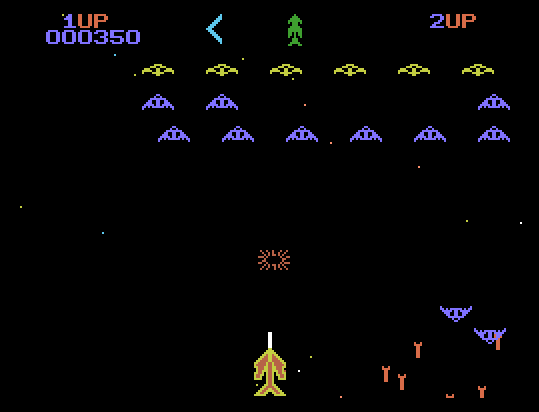


ZX Spectrum Emulator
A device was available called The Speculator that could run some of the catalogue of ZX Spectrum games on the Memotech, with at least 20 popular titles working from launch. Whilst emulation of 80s home computers is now relatively easy because the host machines are vastly faster than the computer they are targeting, in this era it was more difficult as the Spectrum was a contemporary of the Memotech and both machines ran at a similar speed. However, it was feasible since both machines were based around the Z80 processor.
Developed by Tony Brewer and released in 1985, the Speculator was amongst the first commercial home computer emulators. A number of adapters were released for preceding machines that could run software intended for other computers but these most usually contained the great majority of the hardware of the machine they were targeting and were more like buying a clone of the other machine on a card. The Speculator contained only a small amount of additional support logic and was somewhat closer to the emulator concept of enabling one machine to behave as another in software without much additional assistance.
The system consisted of a cartridge that contained logic generating timing signals concerned with Spectrum video production and helped emulate the Spectrum keyboard. A tape was supplied containing the emulator software. The intent was that more tapes would be released in the future with additional Spectrum software supported, although it's not clear if these ever appeared. A different version of the device was also available for the Tatung Einstein.
Image Credits: Memotech MTX 512, by Thomas Conté , Creative Commons Attribution-Share Alike 2.0 Generic; Rear Ports of the Memotech, by Bilby, Creative Commons Attribution 3.0 Unported
